Abstract
This study identifies theoretically based predictors of condom use in a sample of 253 sexually active African-American college students recruited from two historically African-American colleges. The Information-Motivation-Behavioral (IMB) skills model of AIDS-preventive behavior was employed to delineate the roles of HIV/AIDS knowledge, experiences with and attitudes toward condom use, peer influences, perceived vulnerability, monogamy, and behavioral skills. A predictive structural equation model revealed significant predictors of more condom use including: male gender, more sexual HIV knowledge, positive experiences and attitudes about condom use, nonmonogamy, and greater behavioral skills. Results imply that attention to behavioral skills for negotiating safer sex and training in the proper use of condoms are key elements in reducing high risk behaviors. Increasing the specific knowledge level of college students regarding the subtleties of sexual transmission of HIV is important and should be addressed. Heightening students' awareness of the limited protection of serial monogamy, and the need to address gender-specific training regarding required behavior change to reduce transmission of HIV should be an additional goal of college health professionals.
Full text
PDF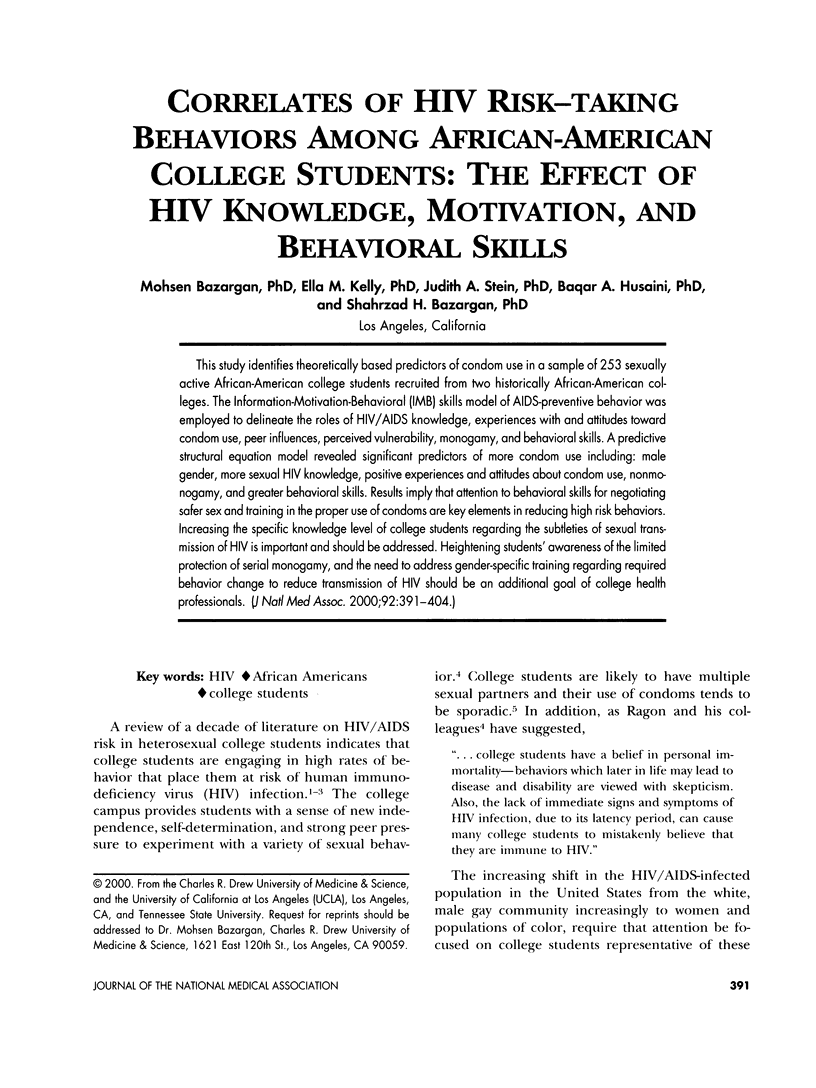
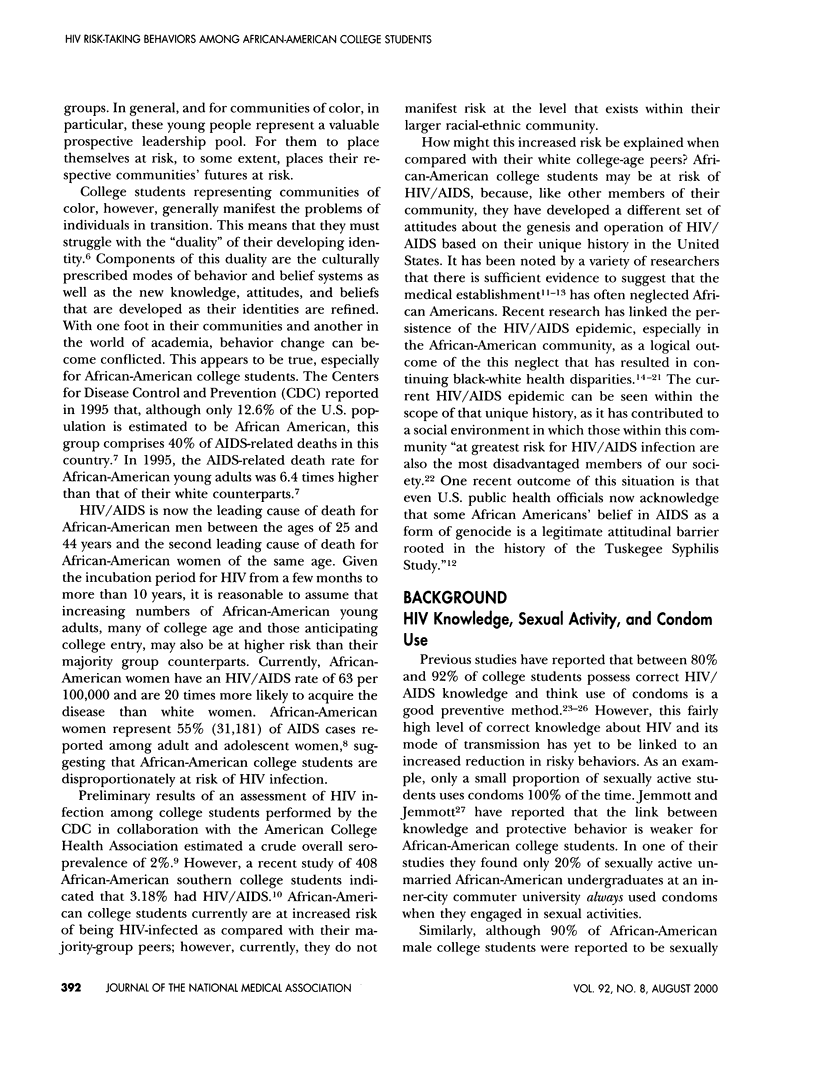
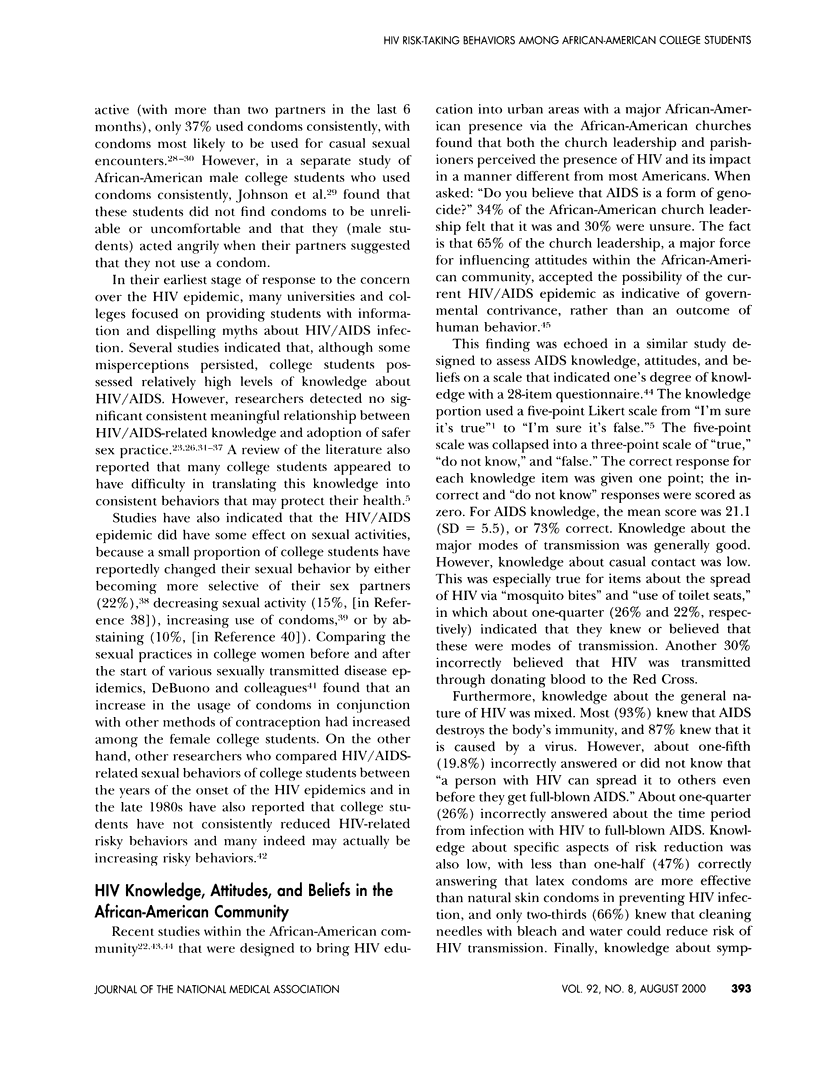
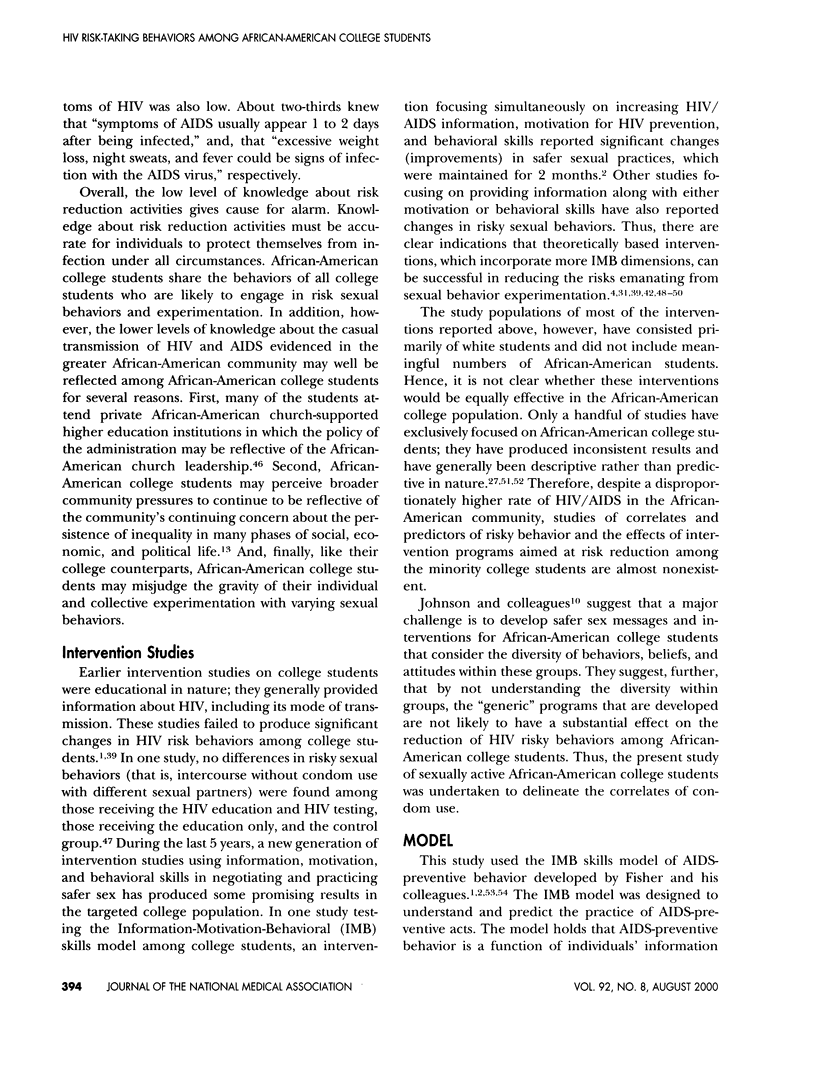
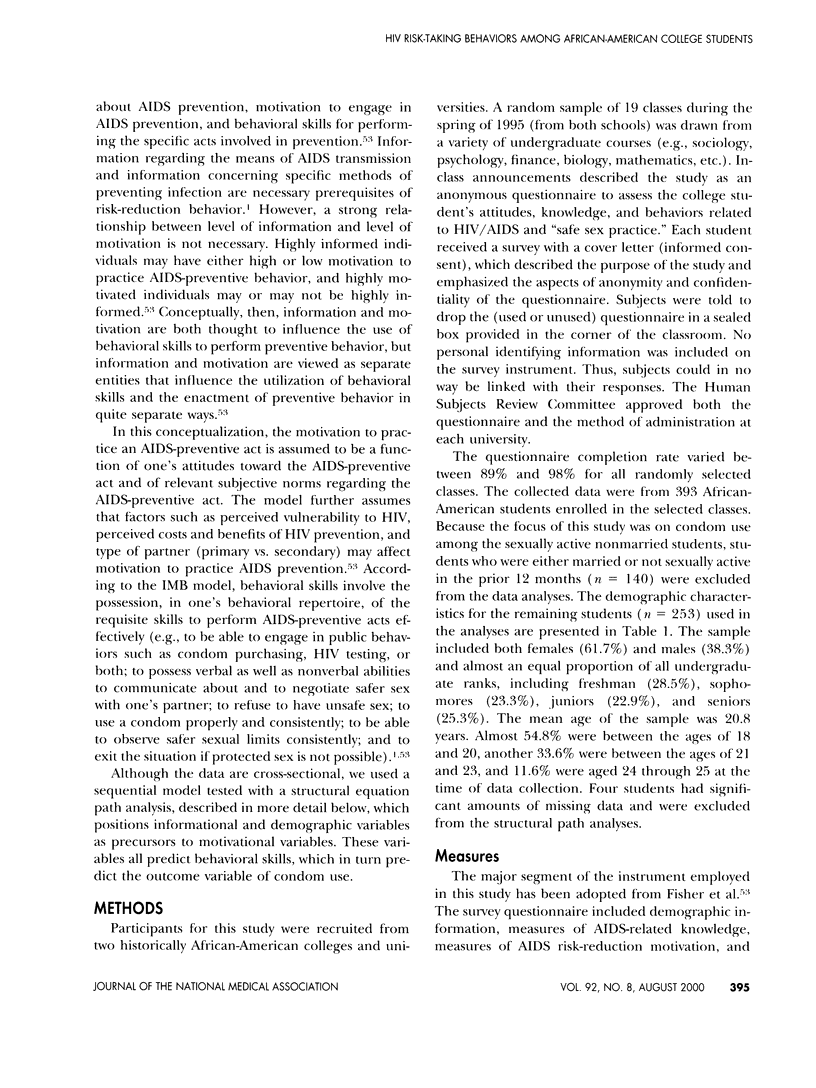


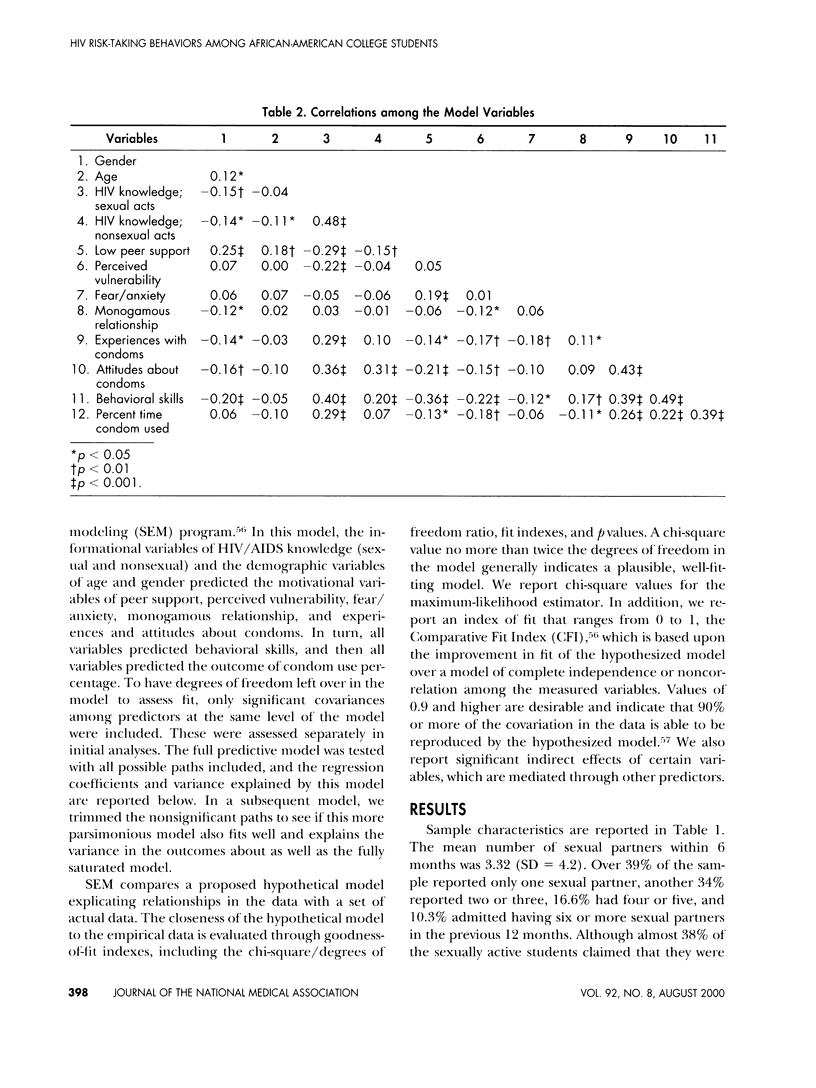
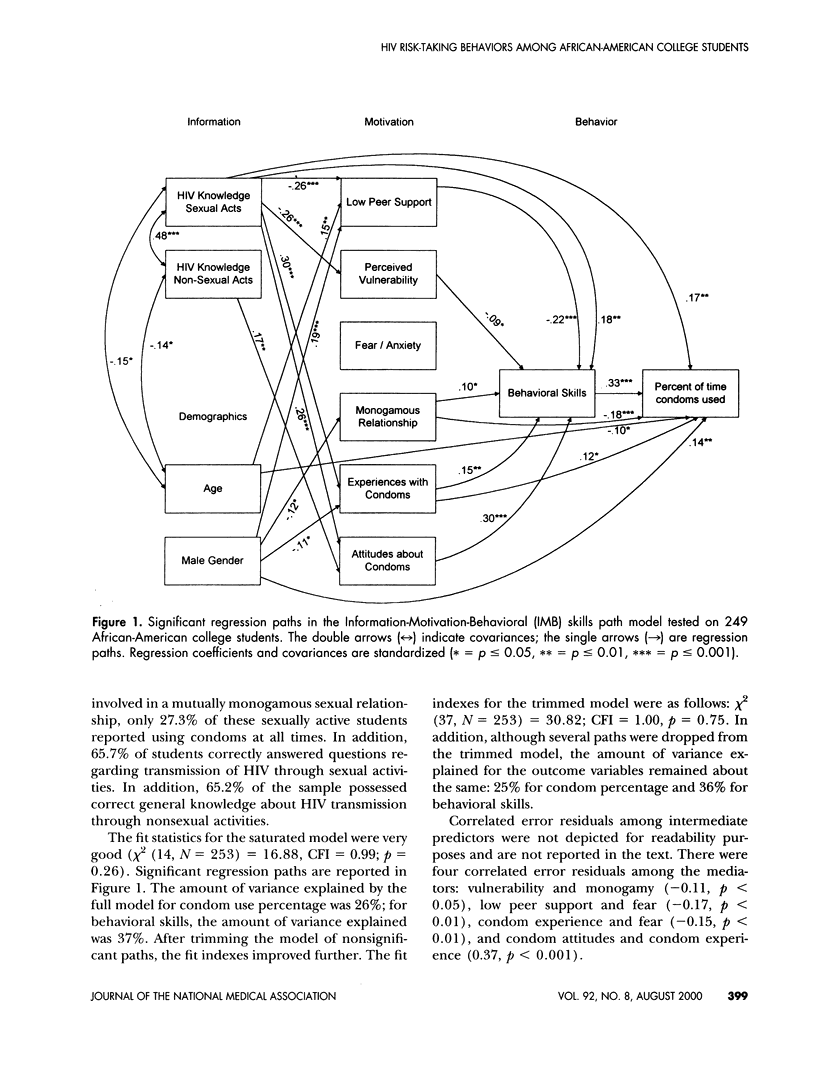
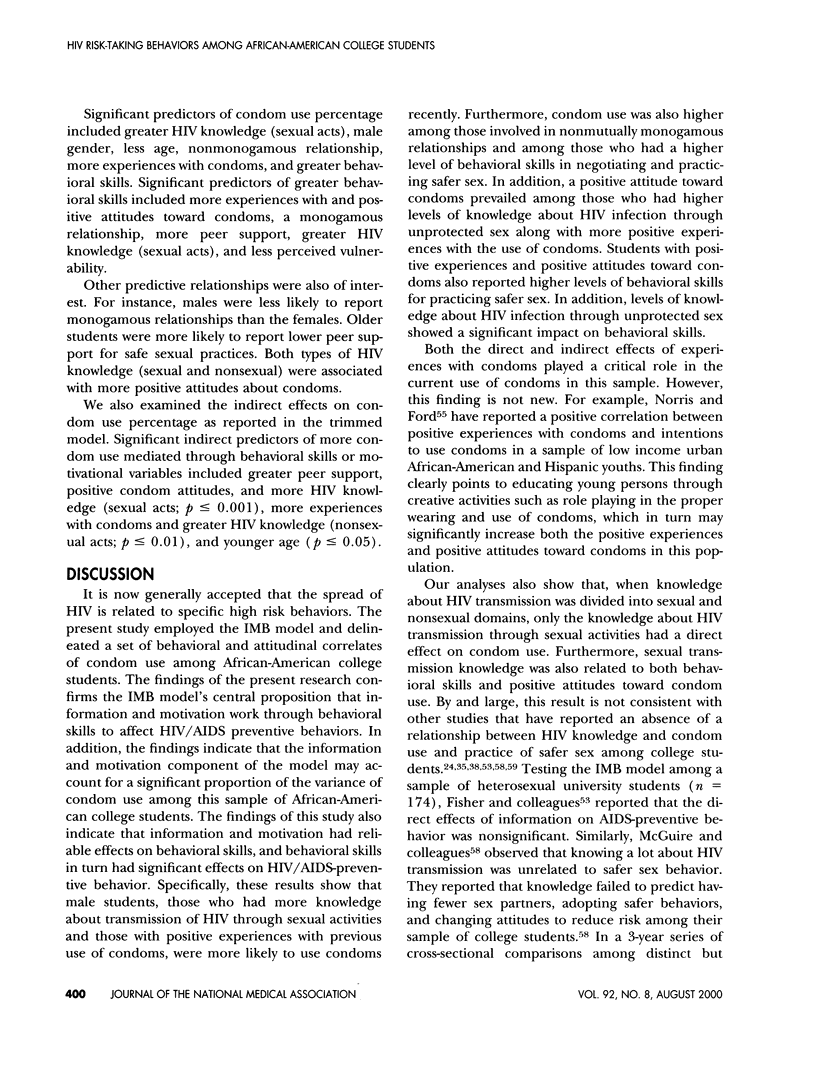
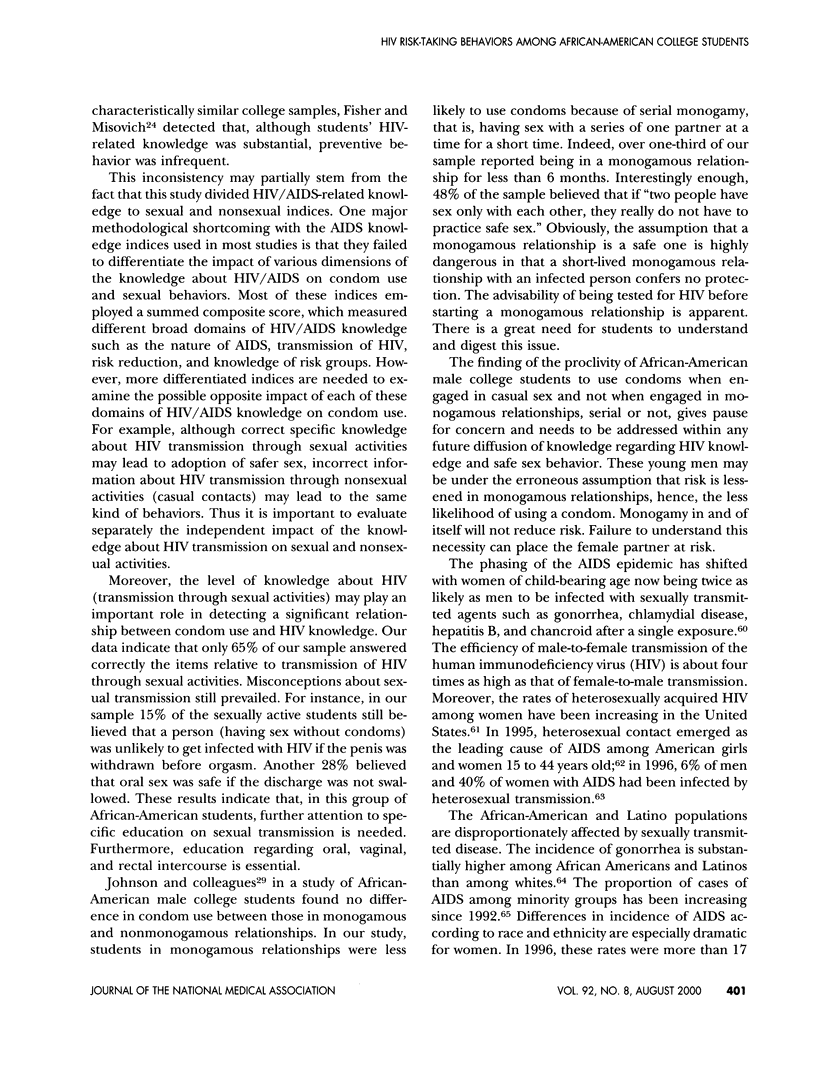
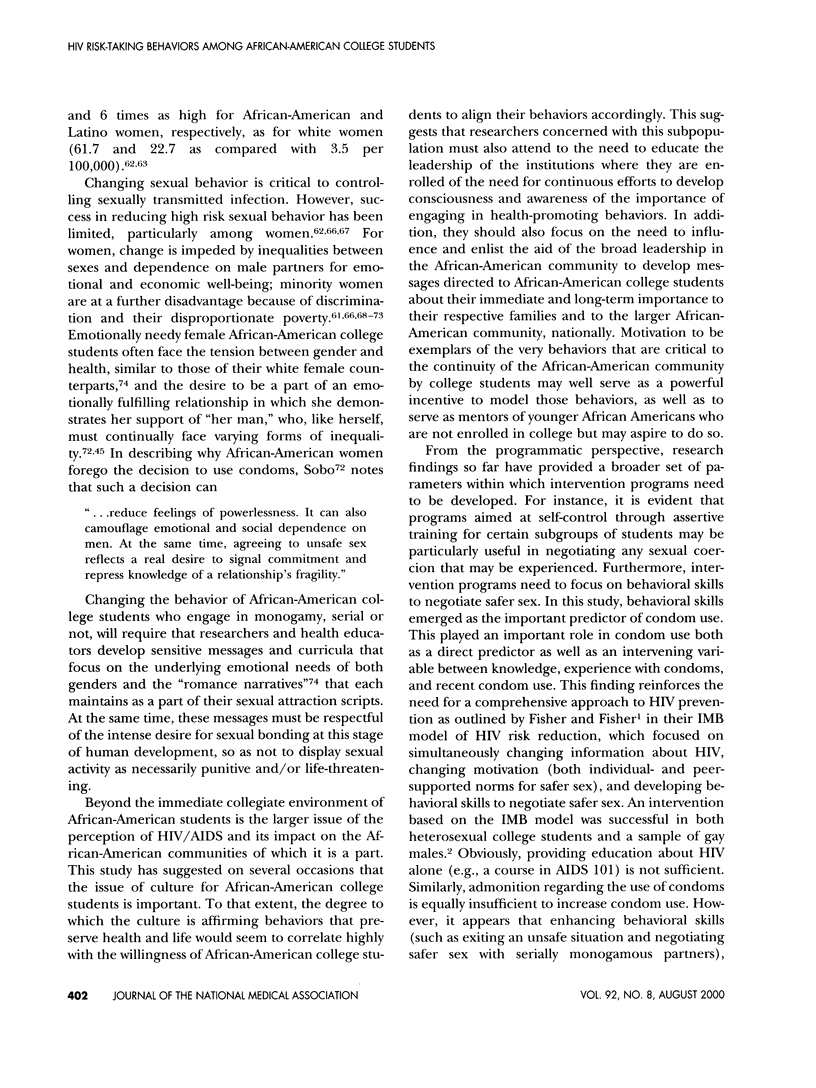
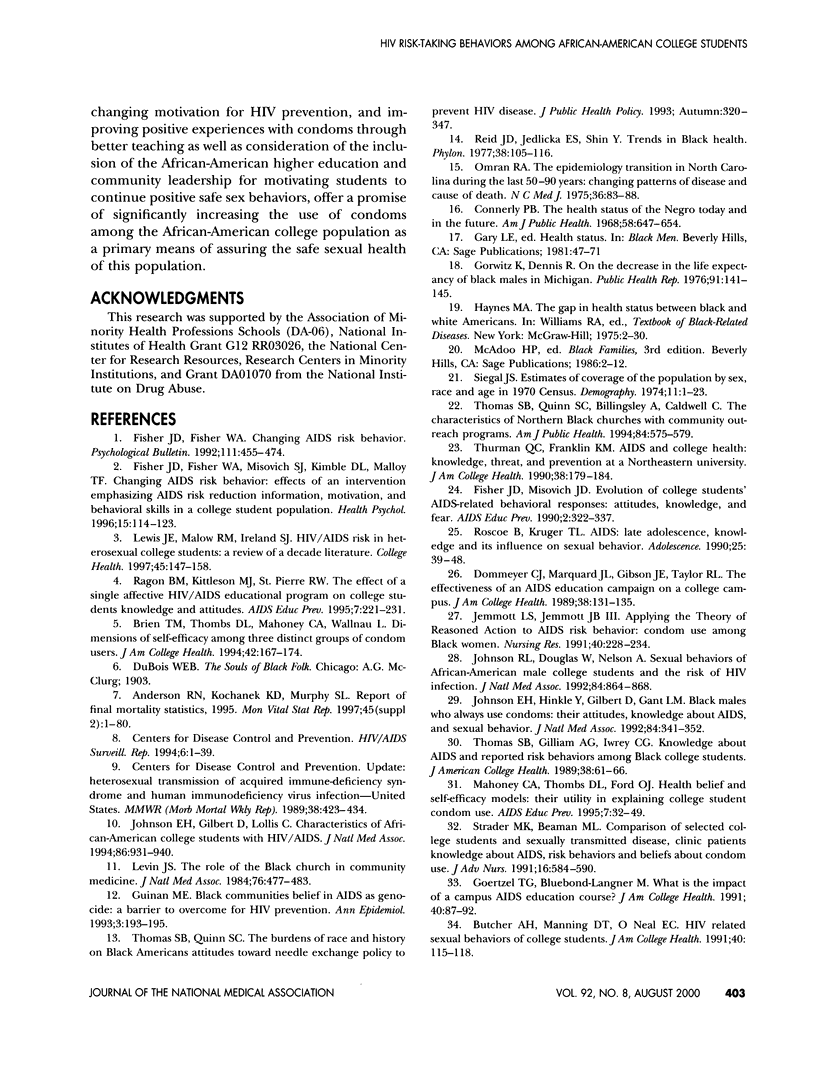
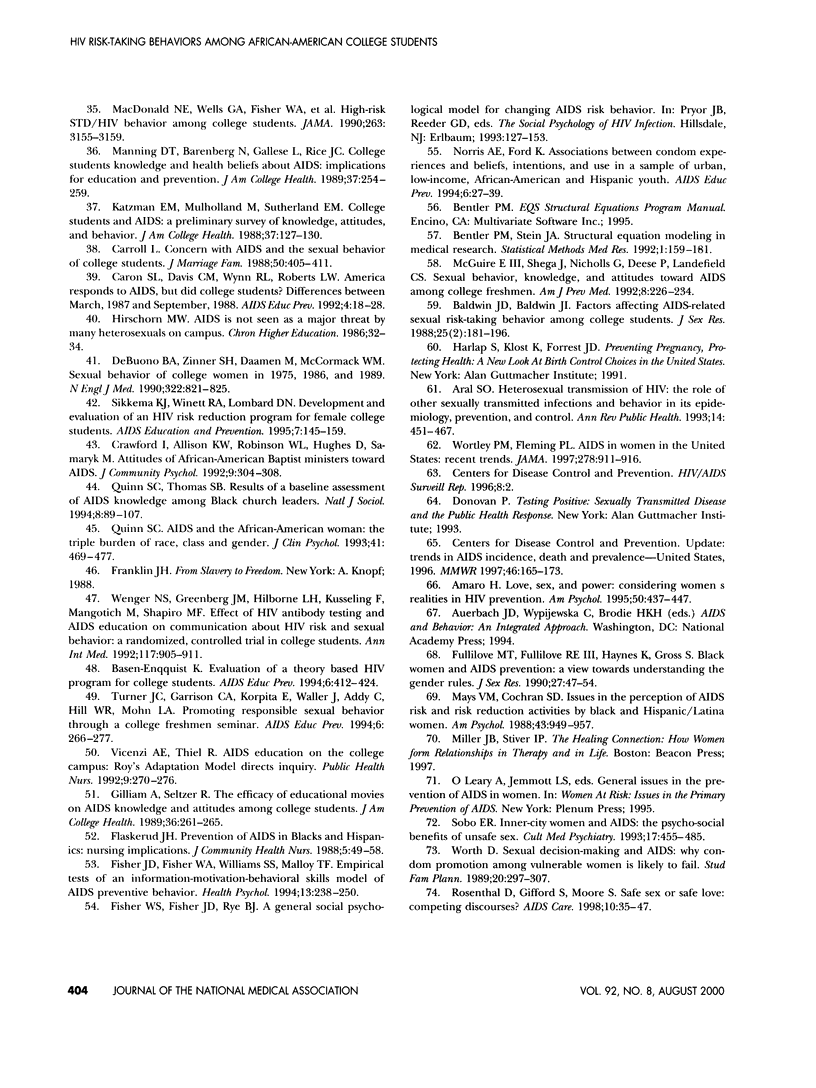
Selected References
These references are in PubMed. This may not be the complete list of references from this article.
- Amaro H. Love, sex, and power. Considering women's realities in HIV prevention. Am Psychol. 1995 Jun;50(6):437–447. doi: 10.1037//0003-066x.50.6.437. [DOI] [PubMed] [Google Scholar]
- Aral S. O. Heterosexual transmission of HIV: the role of other sexually transmitted infections and behavior in its epidemiology prevention and control. Annu Rev Public Health. 1993;14:451–467. doi: 10.1146/annurev.pu.14.050193.002315. [DOI] [PubMed] [Google Scholar]
- Basen-Engquist K. Evaluation of a theory-based HIV prevention intervention for college students. AIDS Educ Prev. 1994 Oct;6(5):412–424. [PubMed] [Google Scholar]
- Bentler P. M., Stein J. A. Structural equation models in medical research. Stat Methods Med Res. 1992;1(2):159–181. doi: 10.1177/096228029200100203. [DOI] [PubMed] [Google Scholar]
- Brien T. M., Thombs D. L., Mahoney C. A., Wallnau L. Dimensions of self-efficacy among three distinct groups of condom users. J Am Coll Health. 1994 Jan;42(4):167–174. doi: 10.1080/07448481.1994.9939665. [DOI] [PubMed] [Google Scholar]
- Butcher A. H., Manning D. T., O'Neal E. C. HIV-related sexual behaviors of college students. J Am Coll Health. 1991 Nov;40(3):115–118. doi: 10.1080/07448481.1991.9936266. [DOI] [PubMed] [Google Scholar]
- Caron S. L., Davis C. M., Wynn R. L., Roberts L. W. "America responds to AIDS," but did college students? Differences between March, 1987, and September, 1988. AIDS Educ Prev. 1992 Spring;4(1):18–28. [PubMed] [Google Scholar]
- Centers for Disease Control (CDC) Update: heterosexual transmission of acquired immunodeficiency syndrome and human immunodeficiency virus infection--United States. MMWR Morb Mortal Wkly Rep. 1989 Jun 23;38(24):423-4, 429-34. [PubMed] [Google Scholar]
- Centers for Disease Control and Prevention (CDC) Update: trends in AIDS incidence, deaths, and prevalence--United States, 1996. MMWR Morb Mortal Wkly Rep. 1997 Feb 28;46(8):165–173. [PubMed] [Google Scholar]
- Cornely P. B. The health status of the negro today and in the future. Am J Public Health Nations Health. 1968 Apr;58(4):647–654. doi: 10.2105/ajph.58.4.647. [DOI] [PMC free article] [PubMed] [Google Scholar]
- DeBuono B. A., Zinner S. H., Daamen M., McCormack W. M. Sexual behavior of college women in 1975, 1986, and 1989. N Engl J Med. 1990 Mar 22;322(12):821–825. doi: 10.1056/NEJM199003223221206. [DOI] [PubMed] [Google Scholar]
- Dommeyer C. J., Marquard J. L., Gibson J. E., Taylor R. L. The effectiveness of an AIDS education campaign on a college campus. J Am Coll Health. 1989 Nov;38(3):131–135. doi: 10.1080/07448481.1989.9938431. [DOI] [PubMed] [Google Scholar]
- Fisher J. D., Fisher W. A. Changing AIDS-risk behavior. Psychol Bull. 1992 May;111(3):455–474. doi: 10.1037/0033-2909.111.3.455. [DOI] [PubMed] [Google Scholar]
- Fisher J. D., Fisher W. A., Misovich S. J., Kimble D. L., Malloy T. E. Changing AIDS risk behavior: effects of an intervention emphasizing AIDS risk reduction information, motivation, and behavioral skills in a college student population. Health Psychol. 1996 Mar;15(2):114–123. doi: 10.1037//0278-6133.15.2.114. [DOI] [PubMed] [Google Scholar]
- Fisher J. D., Fisher W. A., Williams S. S., Malloy T. E. Empirical tests of an information-motivation-behavioral skills model of AIDS-preventive behavior with gay men and heterosexual university students. Health Psychol. 1994 May;13(3):238–250. doi: 10.1037//0278-6133.13.3.238. [DOI] [PubMed] [Google Scholar]
- Fisher J. D., Misovich S. J. Evolution of college students' AIDS-related behavioral responses, attitudes, knowledge, and fear. AIDS Educ Prev. 1990 Winter;2(4):322–337. [PubMed] [Google Scholar]
- Flaskerud J. H. Prevention of AIDS in blacks and Hispanics: nursing implications. J Community Health Nurs. 1988;5(1):49–58. doi: 10.1207/s15327655jchn0501_6. [DOI] [PubMed] [Google Scholar]
- Gilliam A., Seltzer R. The efficacy of educational movies on AIDS knowledge and attitudes among college students. J Am Coll Health. 1989 May;37(6):261–265. doi: 10.1080/07448481.1989.9937492. [DOI] [PubMed] [Google Scholar]
- Goertzel T. G., Bluebond-Langner M. What is the impact of a campus AIDS education course? J Am Coll Health. 1991 Sep;40(2):87–92. doi: 10.1080/07448481.1991.9936261. [DOI] [PubMed] [Google Scholar]
- Gorwitz K., Dennis R. On the decrease in the life expentancy of black males in Michigan. Public Health Rep. 1976 Mar-Apr;91(2):141–145. [PMC free article] [PubMed] [Google Scholar]
- Guinan M. E. Black communities' belief in "AIDS as genocide". A barrier to overcome for HIV prevention. Ann Epidemiol. 1993 Mar;3(2):193–195. doi: 10.1016/1047-2797(93)90136-r. [DOI] [PubMed] [Google Scholar]
- Jemmott L. S., Jemmott J. B., 3rd Applying the theory of reasoned action to AIDS risk behavior: condom use among black women. Nurs Res. 1991 Jul-Aug;40(4):228–234. [PubMed] [Google Scholar]
- Johnson E. H., Gilbert D., Lollis C. Characteristics of African-American college students with HIV/AIDS. J Natl Med Assoc. 1994 Dec;86(12):931–940. [PMC free article] [PubMed] [Google Scholar]
- Johnson E. H., Hinkle Y., Gilbert D., Gant L. M. Black males who always use condoms: their attitudes, knowledge about AIDS, and sexual behavior. J Natl Med Assoc. 1992 Apr;84(4):341–352. [PMC free article] [PubMed] [Google Scholar]
- Johnson R. L., Douglas W., Nelson A. Sexual behaviors of African-American male college students and the risk of HIV infection. J Natl Med Assoc. 1992 Oct;84(10):864–868. [PMC free article] [PubMed] [Google Scholar]
- Katzman E. M., Mulholland M., Sutherland E. College students and AIDS: a preliminary survey of knowledge, attitudes, and behavior. J Am Coll Health. 1988 Nov;37(3):127–130. doi: 10.1080/07448481.1988.9939054. [DOI] [PubMed] [Google Scholar]
- Levin J. S. The role of the black church in community medicine. J Natl Med Assoc. 1984 May;76(5):477–483. [PMC free article] [PubMed] [Google Scholar]
- Lewis J. E., Malow R. M., Ireland S. J. HIV/AIDS risk in heterosexual college students. A review of a decade of literature. J Am Coll Health. 1997 Jan;45(4):147–158. doi: 10.1080/07448481.1997.9936875. [DOI] [PubMed] [Google Scholar]
- MacDonald N. E., Wells G. A., Fisher W. A., Warren W. K., King M. A., Doherty J. A., Bowie W. R. High-risk STD/HIV behavior among college students. JAMA. 1990 Jun 20;263(23):3155–3159. [PubMed] [Google Scholar]
- Mahoney C. A., Thombs D. L., Ford O. J. Health belief and self-efficacy models: their utility in explaining college student condom use. AIDS Educ Prev. 1995 Feb;7(1):32–49. [PubMed] [Google Scholar]
- Manning D. T., Barenberg N., Gallese L., Rice J. C. College students' knowledge and health beliefs about AIDS: implications for education and prevention. J Am Coll Health. 1989 May;37(6):254–259. doi: 10.1080/07448481.1989.9937491. [DOI] [PubMed] [Google Scholar]
- Mays V. M., Cochran S. D. Issues in the perception of AIDS risk and risk reduction activities by black and Hispanic/Latina women. Am Psychol. 1988 Nov;43(11):949–957. doi: 10.1037//0003-066x.43.11.949. [DOI] [PMC free article] [PubMed] [Google Scholar]
- McGuire E., 3rd, Shega J., Nicholls G., Deese P., Landefeld C. S. Sexual behavior, knowledge, and attitudes about AIDS among college freshmen. Am J Prev Med. 1992 Jul-Aug;8(4):226–234. [PubMed] [Google Scholar]
- Norris A. E., Ford K. Associations between condom experiences and beliefs, intentions, and use in a sample of urban, low-income, African-American and Hispanic youth. AIDS Educ Prev. 1994 Feb;6(1):27–39. [PubMed] [Google Scholar]
- Omran A. R. The epidemiologic transition in North Carolina during the last 50 to 90 years: II. changing patterns of disease and causes of death. N C Med J. 1975 Feb;36(2):83–88. [PubMed] [Google Scholar]
- Ragon B. M., Kittleson M. J., St Pierre R. W. The effect of a single affective HIV/AIDS educational program on college students' knowledge and attitudes. AIDS Educ Prev. 1995 Jun;7(3):221–231. [PubMed] [Google Scholar]
- Reid J. D., Jedlicka D., Lee E. S., Shin Y. Trends in black health. Phylon. 1977;38(2):105–116. [PubMed] [Google Scholar]
- Roscoe B., Kruger T. L. AIDS: late adolescents' knowledge and its influence on sexual behavior. Adolescence. 1990 Spring;25(97):39–48. [PubMed] [Google Scholar]
- Rosenthal D., Gifford S., Moore S. Safe sex or safe love: competing discourses? AIDS Care. 1998 Feb;10(1):35–47. doi: 10.1080/09540129850124569. [DOI] [PubMed] [Google Scholar]
- Siegel J. S. Estimates of coverage of the population by sex, race, and age in the 1970 census. Demography. 1974 Feb;11(1):1–23. [PubMed] [Google Scholar]
- Sikkema K. J., Winett R. A., Lombard D. N. Development and evaluation of an HIV-risk reduction program for female college students. AIDS Educ Prev. 1995 Apr;7(2):145–159. [PubMed] [Google Scholar]
- Sobo E. J. Inner-city women and AIDS: the psycho-social benefits of unsafe sex. Cult Med Psychiatry. 1993 Dec;17(4):455–485. doi: 10.1007/BF01379310. [DOI] [PubMed] [Google Scholar]
- Strader M. K., Beaman M. L. Comparison of selected college students' and sexually transmitted disease clinic patients' knowledge about AIDS, risk behaviours and beliefs about condom use. J Adv Nurs. 1991 May;16(5):584–590. doi: 10.1111/j.1365-2648.1991.tb01694.x. [DOI] [PubMed] [Google Scholar]
- Thomas S. B., Gilliam A. G., Iwrey C. G. Knowledge about AIDS and reported risk behaviors among black college students. J Am Coll Health. 1989 Sep;38(2):61–66. doi: 10.1080/07448481.1989.9938417. [DOI] [PubMed] [Google Scholar]
- Thomas S. B., Quinn S. C., Billingsley A., Caldwell C. The characteristics of northern black churches with community health outreach programs. Am J Public Health. 1994 Apr;84(4):575–579. doi: 10.2105/ajph.84.4.575. [DOI] [PMC free article] [PubMed] [Google Scholar]
- Thomas S. B., Quinn S. C. The burdens of race and history on Black Americans' attitudes toward needle exchange policy to prevent HIV disease. J Public Health Policy. 1993 Autumn;14(3):320–347. [PubMed] [Google Scholar]
- Thurman Q. C., Franklin K. M. AIDS and college health: knowledge, threat, and prevention at a northeastern university. J Am Coll Health. 1990 Jan;38(4):179–184. doi: 10.1080/07448481.1990.9938439. [DOI] [PubMed] [Google Scholar]
- Turner J. C., Garrison C. Z., Korpita E., Waller J., Addy C., Hill W. R., Mohn L. A. Promoting responsible sexual behavior through a college freshman seminar. AIDS Educ Prev. 1994 Jun;6(3):266–277. [PubMed] [Google Scholar]
- Vicenzi A. E., Thiel R. AIDS education on the college campus: Roy's adaptation model directs inquiry. Public Health Nurs. 1992 Dec;9(4):270–276. doi: 10.1111/j.1525-1446.1992.tb00112.x. [DOI] [PubMed] [Google Scholar]
- Wenger N. S., Greenberg J. M., Hilborne L. H., Kusseling F., Mangotich M., Shapiro M. F. Effect of HIV antibody testing and AIDS education on communication about HIV risk and sexual behavior. A randomized, controlled trial in college students. Ann Intern Med. 1992 Dec 1;117(11):905–911. doi: 10.7326/0003-4819-117-11-905. [DOI] [PubMed] [Google Scholar]
- Worth D. Sexual decision-making and AIDS: why condom promotion among vulnerable women is likely to fail. Stud Fam Plann. 1989 Nov-Dec;20(6 Pt 1):297–307. [PubMed] [Google Scholar]
- Wortley P. M., Fleming P. L. AIDS in women in the United States. Recent trends. JAMA. 1997 Sep 17;278(11):911–916. [PubMed] [Google Scholar]


